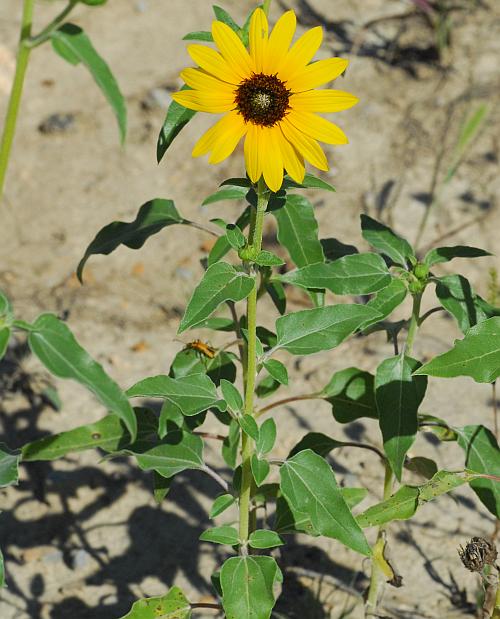Helianthus petiolaris Nutt.
Prairie Sunflower

Native
CC = *
CW = 5
MOC = 14
© SRTurner
Helianthus petiolaris Nutt.Prairie Sunflower | |
 |
Native CC = * CW = 5 MOC = 14 |
© SRTurner |
|
Family - Asteraceae/Heliantheae Habit - Taprooted annual forb. Stem - Ascending to erect, to 1.0 m, single from base, sometimes branched above the midpoint, usually relatively stout, moderately pubescent with short, stiff, ascending hairs.
Leaves - Alternate, simple, long-petiolate, well developed along the stem (usually with 8-25 nodes). Blades of the stem leaves 4-15 cm long, 1-8 cm wide, lanceolate to triangular-ovate (mostly 2-5 times as long as wide), flat, not folded longitudinally, tapered to truncate at the base, tapered to a usually sharply pointed tip, the margins entire or finely and sometimes somewhat irregularly toothed, flat, the surfaces moderately to densely pubescent with short, straight, appressed, somewhat pustular-based hairs (somewhat roughened to the touch), sometimes also with sparse, sessile, yellow glands, more or less with 3 main veins, the lateral pair branching from the midnerve at the base of the blade.
Inflorescences - Open panicles of heads, or less commonly solitary terminal heads. Heads - Radiate. Involucre cup-shaped, 8-14 mm long, 15-25 mm in diameter, mostly shorter than or extending about to the tips of the disc corollas, the bracts in 2-4 subequal series, lanceolate to narrowly ovate, tapered to a sharply pointed, slender, loosely ascending to more commonly spreading or recurved tip, the margins with minute, stiff, ascending to spreading hairs, the outer surface moderately to densely pubescent with short, stiff, loosely ascending to spreading, pustular-based hairs, both surfaces sometimes also with small, sessile, yellow glands. Receptacle flat or slightly convex, the chaffy bracts 5-8 mm long, narrowly oblong-triangular, usually 3-lobed above the midpoint, the lateral lobes tapered to sharply pointed, usually straw-colored, glabrous tips, the middle lobe somewhat differentiated and tapered to a sharply pointed, usually purplish-tinged, densely and conspicuously white-hairy tip, the outer surface usually glabrous below the tip.
Flowers - Ray florets sterile, 12-30, the corolla 1.7-2.5 cm long, glabrous or the upper surface inconspicuously hairy toward the base, both surfaces occasionally also with minute, sessile, yellow glands. Disc florets perfect, the corollas 4.5-6.0 mm long, reddish brown to dark purple (at least the lobes and the upper portion of the tube). Pappus of 2 scales 1.5-3.0 mm long, these narrowly lanceolate-triangular, tapered to a sharply pointed, often minutely awnlike tip, more or less papery, rarely also with 1 or 2 additional oblong scales 0.2-0.5 mm long.
Fruits - Achenes 3.0-4.5 mm long, narrowly wedge-shaped to obovate, flattened but usually more or less 4-angled in cross-section, the surface moderately densely and usually persistently pubescent with fine, ascending hairs, finely mottled with dark brown and lighter brown patches. Flowering - May - October. Habitat - Upland prairies, sand prairies, tops of bluffs, quarries, railroads, roadsides, open disturbed areas. Often in sandy soil. Origin - Native to the U.S. Lookalikes - H. annuus, which is probably considerably more common in Misssouri. Other info. - To judge from herbarium specimens, this species is relatively uncommon in Missouri. It may be underreported, as it closely resembles the common sunflower, H. annuus. It is differentiated from that species by a few subtle characters, including conspicuous white hairs at the tips of the disk chaff, bristly spreading hairs on the phyllaries, and achenes which remain hairy at maturity. The plants are otherwise recognized by having broad, alternate leaves and dark-colored disk florets. The subspecies which occurs in Missouri, ssp. petiolaris, mainly occurs in a broad band extending from Texas through Montana and North Dakota, and continuing into Canada. Missouri represents a far eastern extension of the main range. Photographs taken at St. Joe State Park, St. Francois County, MO, 8-29-2019 (SRTurner). |